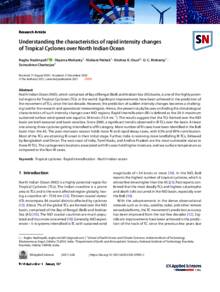Document
North Indian Ocean tropical cyclone activity in CMIP5 experiments : future projections using a model-independent detection and tracking scheme.
Identifier
DOI: 10.1002/joc.6594
Source
International Journal of Climatology. v. 40, 15, p. 6492-6505
Contributors
Country
United States.
Publisher
John Wiley and Sons Ltd.
Gregorian
2020-12-01
Language
English
Subject
English abstract
The sensitivity of tropical cyclone (TC) projection results to different models and the detection and tracking scheme used is well established. In this study, future climate projections of TC activity in the North Indian Ocean (NIO) are assessed with a model- and basin-independent detection and tracking scheme. The scheme is applied to selected models from the coupled model intercomparison project phase 5 (CMIP5) experiments forced under the historical and representative concentration pathway 8.5 (RCP8.5) conditions. Most models underestimated the frequency of early season (April–June) TCs and contained genesis biases equatorward of ~7.5°N in comparison to the historical records. TC tracks detected in reanalysis and model data were input to a clustering algorithm simultaneously, with two clusters in the Arabian Sea and two in the Bay of Bengal (k = 4). Projection results indicated a slight decrease of overall TC genesis frequency in the NIO, with an increase of TC genesis frequency in the Arabian Sea (30–64%) and a decrease in the Bay of Bengal (22–43%), consistent between clusters in each of these sub-regions. These changes were largely due to changes in the pre-monsoon season (April–June) where Bay of Bengal TCs significantly decreased, consistent with changes in vertical ascent. Northern Arabian Sea TCs significantly increased during the pre-monsoon season, consistent with changes in vertical wind shear and relative humidity. There was a projected increase of TC frequency in the post-monsoon season (October–December), consistent with changes in relative humidity and vertical ascent, although not all clusters followed this trend; noting a different response in the southern Bay of Bengal. In turn, these projections caused changes to the climate averaged TC track density, including a decrease (up to 2 TCs per decade) affecting the eastern coast of India and a small increase (up to 0.5 TCs per decade) affecting eastern Africa, Oman and Yemen.
ISSN
0899-8418
Category
Journal articles



